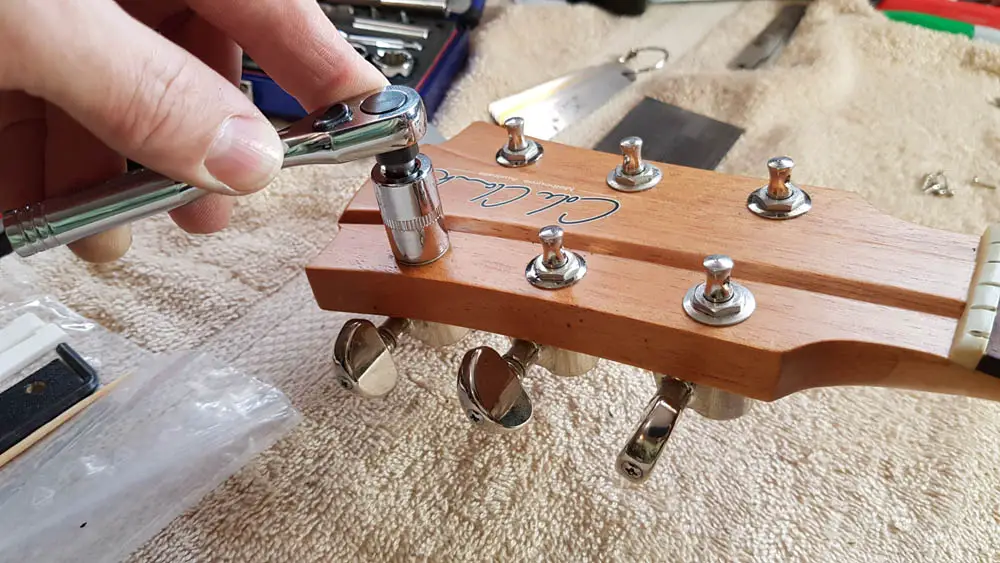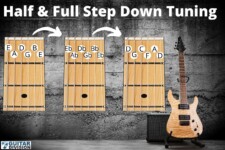Why Does My Guitar Buzz When I Strum? (How to Fix It)
Buzzing sounds when you strum your guitar can be really annoying, and can distract you when you’re playing.
There can be a few reasons why your guitar buzzes, and sometimes it’s only when you strum that the problem seems to be heard.
Electric guitars are more likely to buzz when strumming due to having a lower action and thinner strings, and have more parts that can become loose over time.
Basically, there are only two main reasons why your guitar buzzes, and it’s down to either your playing technique or an issue with your guitar.

Why Is My Guitar Making a Buzzing Noise?
Let’s first presume you’re an awesome guitar player and start by blaming the guitar!
If you don’t hear any buzzing when finger picking or flat picking notes, then the buzzing can be as simple as some loose hardware, but could be as serious as a crack in your guitar.
General Guitar Buzzing Causes
Some problems are found on both electric and acoustic guitars, while others are more specific to one or the other.
1. Loose tuners
These are a common cause of buzzing, and often it takes the energy of strumming to make the problem heard. With the regular vibrations that go through your guitar, hardware like tuners can work its way loose with a slight buzzing becoming louder over time.
Use a small spanner to check the nuts on the front of your tuners, and ensure they are firm (not too tight). Then use a screwdriver to check that the winder buttons are not loose. If your tuners have screws into the headstock check those also.

2. Uneven Frets
If your guitar sounds fine when playing solo notes then this is less likely, however sometimes a fret slightly higher than the others (or a worn fret) can cause buzzing when strumming due to the extra vibration.
Look at the other problems first if the frets don’t stand out as a problem.
3. Nut Slots too Wide
If the slots in the nut are too wide it can allow the string to rattle around in the slot under the heavier vibration that strumming causes. This is more likely on the thinner strings, and you can test this by picking each open string firmly while listening for any sitar-like buzzing sounds.
4. Cracks in the Guitar
Sometimes a small crack won’t be noticed, but when you strum harder can cause audible buzzing. This can happen on any guitar type, especially if it’s taken a knock, or been through rapid temperature or humidity changes.
Have a look around your guitar carefully for any signs of cracking. Common places are where the headstock joins on to the neck, and the neck joint to the guitar body.
Acoustic Guitar Buzzing Causes
Acoustic guitars can be damaged more easily than electric guitars, and solid top acoustics can develop fine cracks in the soundboard (top) if they are not handled and stored correctly.
A crack anywhere on the body is likely to buzz when you strum, so carefully inspect for this if nothing else stands out.
1. Loose Bridge
Sometimes the bridge can start coming loose from a guitar, and while it still holds the strings there can be a slight gap under part of it that causes buzzing when you strum.
Look carefully around the edges of the bridge for any signs of cracking.
2. Bridge Pins
Bridge pins can also be a cause of buzzing if they were not inserted fully when changing strings, or the string ball was not pulled up properly to the pin.
If you notice a pin higher than the others, then try slacking the tension off each string and firmly push the bridge pins down to ensure they are seated correctly.
3. Incorrect string Fitting
If you notice a string going out of tune sometimes and the tuner seems to be fine, then you could have a string where the ball-end was not pulled up properly against the pin, and this loose end can also cause buzzing inside the guitar.
4. Loose Internal Bracing
This can be very difficult to detect being inside the guitar, but will certainly cause buzzing when you strum heavily. If you notice buzzing after your guitar has taken a fall or a knock, this can be a possibility.
Sometimes the only way to detect a problem like this is with a stethoscope like your doctor would use, and checking different areas on the guitar body while you strum the strings.
Electric Guitar Buzzing Causes
Specific to electric and acoustic-electric guitars is the electronic hardware fitted in the guitar.
1. Pickups & Sound Controls
Pickups are mostly mounted with screws, and are designed to float on small springs. If you find one of the pickup screws has become loose or fallen out, then you can get buzzing.
The control knobs in most guitars have a nut hidden under the knob, and these frequently work their way loose and can cause buzzing, noticed when you strum the guitar harder.
If your controls are a bit loose, then gently pry the knobs off, and tighten the nut underneath.
2. Bridge Vibration
Electric guitar bridges have many screws and parts and can easily be a point of buzzing sounds. Check your bridge with a screwdriver and hex-key to ensure there are no sneaky loose items.
3. Input jack
These are used almost every time you play your guitar, and many come loose easily. They are quick and easy to check, and is something you can do regularly to prevent buzzing.
4. Pickguard
These are held on with small screws, and over time the holes in your guitar can become stripped, allowing the screws to get loose and allow rattling noises.
Check these screws, and if the screws won’t screw back up tightly you can push a toothpick in the hole, break the end off, and then put the screw in again.
Guitar Playing Technique Buzzing Issues
So we’ve looked at many reasons why your guitar could cause buzzing when you strum, however if your guitar is fine, then the problem may be your technique.
1. Bar Chords
If you are just learning bar chords and find that there are buzzing sounds, then it can often come down to the strings not firmly touching the fret for the barred finger (usually 1st finger).
Try moving your barred finger slightly higher toward the low string, or down a little toward the high E string and see if this makes a difference.
Also note the position of the barred finger; it should be as close to the fret as possible without being on top of it. Having a barred finger too far back will cause the strings to buzz on that fret.
2. Capo & Finger Position
If you are using a capo and have it positioned too far back from the fret, you can get string buzzing sounds the same as with bar chords.
Capo’s need to be close to the bar without touching it, and this is also true for finger placement when playing notes or chords.
3. Capo Tension
If your capo does not clamp the strings down with enough pressure, the strings can rattle on the next fret.
If your capo is adjustable, then ensure it is tight enough to hold the strings down firmly at a few places on the neck, without being so tight that it causes notes to sound sharp.




